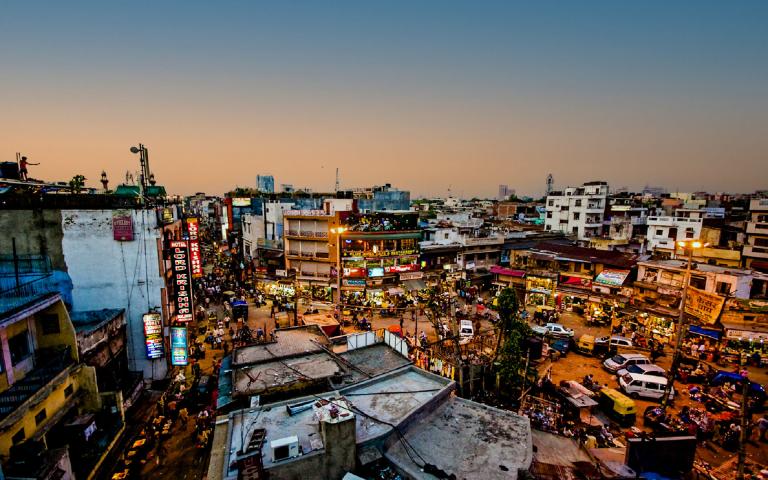From Rio's samba spectacle to Venice's masked elegance, explore 10 unique festivals that showcase human creativity, cultural diversity, and the universal spirit of celebration. Uncover…


New Delhi, the capital of India, is a dynamic city located inside the National Capital Territory of Delhi (NCT). New Delhi, with a population over 250,000, functions as the nucleus of Indian governance and epitomizes the country’s historical legacy and contemporary ambitions. This vibrant metropolis, spanning 42.7 square kilometers (16.5 square miles), exemplifies India’s imperial heritage and its evolution into a worldwide powerhouse.
New Delhi, being the headquarters of the three arms of the Indian government, accommodates the Rashtrapati Bhavan (Presidential Palace), Sansad Bhavan (Parliament House), and the Supreme Court. These emblematic edifices serve as bastions of democracy, encapsulating the values upon which contemporary India was established. The city holds importance beyond its administrative function, embodying the core of Indian politics, diplomacy, and national identity.
The origin of New Delhi as it exists now may be attributed to the Delhi Durbar in 1911, at which King George V inaugurated its foundation stone. British architects Edwin Lutyens and Herbert Baker were assigned the significant responsibility of creating the new capital, intended to embody the magnificence of the British Empire while integrating aspects of Indian architectural tradition. Their vision culminated in the opening of New Delhi on February 13, 1931, by Viceroy and Governor-General Irwin, signifying a new chapter in the city’s distinguished history.
New Delhi is located on the Indo-Gangetic Plain, noted for its predominantly flat landscape. The city’s topography is characterized by the Delhi Ridge, commonly known as the “Lungs of Delhi,” which remains a vestige of the former Aravali Range. This geological feature enhances the city’s topographical variety and is vital to its ecological equilibrium. To the east, the urban area of Shahdara extends beyond the Yamuna River, which, despite its nearness, effectively leaves New Delhi landlocked.
The economic importance of New Delhi is undeniable. As the preeminent commercial center in northern India, it features a substantial State Domestic Product and a per capita income that is among the highest nationally. Connaught Place, an extensive commercial and financial hub, predominates the city’s economic environment, acting as the central nucleus of North Indian commerce. Proximate regions such as Barakhamba Road and ITO reinforce New Delhi’s position as a crucial business hub.
The government and quasi-government sectors have historically been the principal employers in New Delhi; nonetheless, the city has experienced significant growth in its service sector. This expansion is due to the presence of a proficient, English-speaking labor force that has drawn many global companies. Principal sectors propelling the city’s economic engine are information technology, telecommunications, hospitality, banking, media, and tourism. This diversification has enhanced New Delhi’s economic resilience and established it as a worldwide corporate hub.
The multicultural essence of New Delhi is a distinctive attribute. The city’s status as the national capital has attracted individuals from around India, resulting in a diverse amalgamation of cultures, languages, and traditions. The diverse ethnic and cultural milieu is augmented by diplomatic posts, international organizations, and a growing expatriate community. The resultant cultural mosaic is evident in the city’s gastronomy, festivals, art, and quotidian existence, rendering New Delhi a genuine melting pot of Indian culture.
National festivals and holidays possess considerable importance in New Delhi, frequently commemorated with exceptional enthusiasm and magnificence. The Republic Day Parade, conducted on January 26th, is a magnificent exhibition of India’s cultural legacy and military strength, attracting numerous spectators and dignitaries around. Independence Day, celebrated on August 15th, features the Prime Minister delivering a speech to the country from the historic Red Fort, while inhabitants around the city engage in kite flying as a representation of independence and solidarity. Other national holidays, such as Gandhi Jayanti, honor India’s founding fathers and reaffirm the values upon which the nation was established.
The religious and cultural calendar of New Delhi is filled with events that exemplify the city’s tolerant nature. The city welcomes the variety of its inhabitants via the exuberant holidays of Diwali and Holi and the solemn observances of Eid and Christmas. Cultural events such as the Qutub Festival, set against the magnificent Qutub Minar, underscore New Delhi’s dedication to conserving and promoting India’s rich creative history. The International Mango Festival and the Kite Flying Festival enhance the city’s cultural attractions, drawing people from far locations.
In recent years, New Delhi has evolved as a hub for spiritual and religious interaction. The establishment of a Peace Pagoda by the Japanese Buddhist group Nipponzan Myohoji, unveiled by the Dalai Lama, highlights the city’s contribution to promoting world understanding and harmony. This monument enhances New Delhi’s architectural variety and symbolizes peace in an often divided globe.
New Delhi’s connection is essential for its operation and development as a global city. Indira Gandhi International Airport, situated southwest of the city, functions as the principal hub for domestic and international aviation travel. The airport, including its advanced Terminal 3, which accommodates over 37 million passengers each year, has emerged as one of the busiest in South Asia. This premier infrastructure not only enables the transit of individuals and commodities but also exemplifies India’s expanding prominence on the international arena.
Currency
Founded
Calling code
Population
Area
Official language
Elevation
Time zone
India, the most populous nation in the world and the seventh-largest by land area, is a land of extraordinary diversity and a captivating history nestled in South Asia. As of 2023, India has elegantly surpassed China, boasting…
Ahmedabad is the most populous city in Gujarat, India, with a population of 8,854,444 as of 2024, establishing it as a prominent urban hub in the nation. This dynamic city, located along the Sabarmati River, functions as…
Bangalore, officially known as Bengaluru, stands as the capital and largest city of Karnataka, a southern Indian state. Positioned strategically on the Deccan Plateau, this bustling metropolis boasts a population…
Chennai, the dynamic capital of Tamil Nadu, displays India’s profound cultural legacy and swift modernity. Located on the Coromandel Coast of the Bay of Bengal, this city has a population of around 7.1 million, ranking it as the sixth-most…
Goa, a little yet dynamic state on India’s southern coast, is an enchanting amalgamation of natural splendor, historical richness, and cultural variety. Located in the Konkan area, this seaside beauty has a population of around…
Mumbai, the capital of Maharashtra, is India’s financial hub and most populous city, with an estimated population of 12.5 million inhabitants. This dynamic city is the core of the Mumbai Metropolitan Region, the sixth-largest…
Jaipur, the capital and biggest city of Rajasthan, exemplifies India’s profound cultural legacy and contemporary urban advancement. As of 2011, with a population of 3.1 million, it is the ninth most populated city in the nation. Located 268 kilometers…
Kolkata, originally referred to as Calcutta, serves as the capital and most populous city of the Indian state of West Bengal, located on the eastern bank of the Hooghly River. Kolkata has an estimated population of 4.5…
Hyderabad, the capital and biggest city of Telangana, is a dynamic metropolis that harmoniously integrates ancient past with contemporary advancement. Located in the northern region of Southern India, this extensive metropolitan hub…
Agra, a city steeped in historical significance and cultural opulence, graces the banks of the Yamuna river in the northern Indian state of Uttar Pradesh. Situated around 230 kilometers southeast of New Delhi, the national capital, and…
From Rio's samba spectacle to Venice's masked elegance, explore 10 unique festivals that showcase human creativity, cultural diversity, and the universal spirit of celebration. Uncover…

Millions of visitors come to Spain annually because of its vibrant culture, fascinating past, and amazing scenery. Still, the real spirit of Spain is found…

While many of Europe's magnificent cities remain eclipsed by their more well-known counterparts, it is a treasure store of enchanted towns. From the artistic appeal…

Boat travel—especially on a cruise—offers a distinctive and all-inclusive vacation. Still, there are benefits and drawbacks to take into account, much as with any kind…

Discover the vibrant nightlife scenes of Europe's most fascinating cities and travel to remember-able destinations! From the vibrant beauty of London to the thrilling energy…

© All Rights Reserved. By Travel S Helper